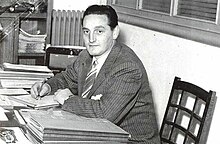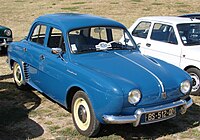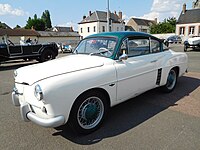Luigi Segre
Luigi Segre | |
|---|---|
 | |
| Born | 8 November 1919 |
| Died | 28 February 1963 (aged 43) Turin, Italy |
| Nationality | Italian |
| Other names | Gigi |
| Occupation(s) | Automotive designer and businessman |
| Known for | Designer and owner at Carrozzeria Ghia and OSI |
Luigi "Gigi" Segre (8 November 1919 – 28 February 1963) was an Italian automotive designer noted for his business and engineering acumen[1] during his stewardship and ownership of Carrozzeria Ghia (1953–63), one of an Italy's premier automobile design and coachbuilders.[2]
Segre is widely associated with his prominent role in the genesis of the Volkswagen Karmann Ghia – a car that reached a production of nearly a half million, and a car that noted designer Dick Teague called one of the "most beautifully designed products."[3]
Background
[edit]Segre began working at his father's construction business, only to have his career and education interrupted by the outbreak of World War II. Stationed in Naples on 8 September 1943, when the armistice was announced, Segre immediately voiced opposition to the German troops occupying the city – and participated in the Four days of Naples. When allied troops arrived, he made himself available to the US command, and after a brief training in Tunisia, parachuting into the Canavese, he became an official liaison between the Office of Strategic Services (OSS) – precursor to the modern CIA – and partisan groups working in the Piedmont. He also worked to repatriate former Italian soldiers from France. It was during this period, Segre had begun to master English and become familiar with the American way of thinking.[4]
Following positive recommendations from the Allied Command in the immediate post-war period, Segre was hired as a manager at Ford, graduated in engineering[4] and subsequently moving to Siata (Società Italiana Auto Trasformazioni Accessori) where he studied automotive design with Giorgio Ambrosini. In a brief racing career, Segre took 1949 and 1950 first place victories in the Mille Miglia Turismo 1100 class (in a Fiat 1100)[4] – with teammate Gino Valenzano (1920–2011).[5]
Segre married Luisa de Berto in 1955 and together they had sons Edmondo (1957-) and Silvio (1959-). Luigi Segre died suddenly and unexpectedly in a Turin clinic at age 43, during convalescence after successful removal of kidney stones. Doctors suspected Segre had contracted a viral infection during a recent business trip to Brazil, but at the time the hypothesis could not be confirmed. He left behind his wife, Luisa, and two sons, at the time 6- and 4-years old. In 1971, Luisa Segre opened a resort, La Meridiana, between Monaco and Portofino, as of 2018 operated by Edmondo Segre and his wife Alessandra.[6]
Career
[edit]Before turning thirty,[4] Segre joined Carrozzeria Ghia in 1948, hired by Mario Boano as Commercial Director, then becoming a minority owner. Using his nickname "Gigi," he actively toured Italy, contacting and personally meeting all Ghia's dealers.[4] Orders increased, his income tied to a percentage of orders. As the Carrozzeria's Director of Sales, Segre would leave to consummate a deal estimated at ten million, returning with a contract for thirty million.[4]
Eventually, English-speaking Segre would travel to the United States to meet Chrysler's chief stylist Virgil Exner and CEO K. T. Keller.[2] Segre served as Ghia's interlocutor as Boano did not speak English[1] – leaving Segre to forge strong personal alliances with Exner and Chrysler while leaving Mario Boano in a diminished role within his own company. For Segre, a working alliance with Chrysler provided the valuable opportunity to elevate Carrozzeria Ghia's international stature.[4] Exner in turn was able to quickly see actual prototypes of his studio's work[4] – at a dramatically lower cost (e.g., one tenth to one twentieth) than Chrysler was producing its prototypes.[7] Segre became full owner of Carrozzeria Ghia in 1954, after Mario Boano left over their differences – Boano wanting Ghia to focus on local work and Segre wanting to form international liaisons.[1]
Segre developed contracts with Volkswagen, Renault, Fiat, Volvo and several others to continuously develop their show cars, as well as possible production models and facelifts. In 1953, Segre worked with Renault, when the company chairman, Pierre Lefaucheux, requested Ghia's assistance with the forthcoming Dauphine.[8][9]
After modernizing Ghia, Segre realized further expansion could detrimentally affect Ghia's reputation as a prestigious artisanal workshop – subsequently founding a new company, controlled by Ghia, in partnership with Arrigo Olivetti (1889–1967). Inaugurated in 1960 in a new building adjacent to the main Ghia factory, Officine Stampaggi Industriali (OSI) relied heavily on the most modern equipment and techniques, with sheet metal stamping, painting, final assembly and various finish works – to satisfy client requirements without damaging Ghia's boutique image.
After Segre's death, his widow sold most of Ghia to Dominican dictator Ramfis Trujillo in 1965.
Karmann Ghia
[edit]Three companies and numerous individuals came together in the history of the Karmann Ghia. In the early 1950s, Volkswagen was producing its Volkswagen Beetle, and as post-war standards of living increased, executives at Volkswagen had toyed with adding a halo model to its range. Luigi Segre was committed to expanding the international reputation of Carrozzeria Ghia. And Wilhelm Karmann had overtaken his family coachbuilding firm Karmann and was eager to augment his contracts building Volkswagen's convertible models.
Segre and Karmann encountered each other at international automobile shows, and after an initial discussion prompted by Wilhelm Karmann, Segre secretly began working, obtaining a Volkswagen Beetle to use as a basis for a prototype[10][2] – The Type I's were difficult to come by and Gian Paolo, Mario Boano's son, purchased one in Paris and drove it back to Turin.[11] Ghia customized its platform, designed the initial prototype and in five months constructed the model.
Segre, again secretly, presented the model to Wilhelm Karmann one year after the initial discussion – late in 1953, in Paris, at the Societé France Motors factories (Volkswagen's dealership for France and the exclusive European dealer of Ghia-built Chrysler models).[12] When Wilhelm Karmann saw the coupe, Karmann he said, "I'd like to build that!"[7] As the head of Ghia, Segre singularly directed the project through conception and prototyping, delivering a feasible project that Willhelm Karmann both wanted to and could practically build – the project Willhelm Karmann would in turn present to Volkswagen.
The styling of the Karmann Ghia integrated work by Segre as well as Mario Boano, Sergio Coggiola and Giovanni Savonuzzi – and at various times they each took credit for the design.[13] Furthermore, the design bore striking styling similarities to Virgil Exner's Chrysler d'Elegance and K-310 concepts, which Ghia had been tasked with prototyping – and which in turn reflected numerous cues and themes developed previously by Mario Boano.[10] According to Virgil Exner's son, Virgil M. Exner Jr., Giovanni Savonuzzi was tasked with scaling down the full-sized d'Elegance, replacing "the Chrysler's egg-crate grille with a gentle, boat-like prow."[14] Exner Jr. is further quoted as saying that the Karmann Ghia "was a direct, intentional swipe off the Chrysler d'Elegance. Givanni Savonuzzi was the engineer and designer who downsized the d'Elegance and made the Karmann Ghia out of it. Nobody minded it. It was wonderful".[11]
The precise styling responsibilities were not well-documented at the time, before the passing of the various designers,[10] further complicated by the overlapping work of the key players. A definitive individual attribution on Karmann Ghia's styling was never made.[10]
Segre and Virgil Exner had become close professionally and personally, eventually traveling Europe together, with their families.[15] Peter Grist wrote in his 2007 Exner biography that when Exner in 1955 eventually saw the Karmann Ghia, which cribbed heavily from his Chrysler d'Elegance, "he was pleased with the outcome and glad that one of his designs had made it into large-scale production".[16] Chris Voss, a stylist in Exner's office, reported in 1993, that Exner considered the Karmann Ghia the ultimate form of flattery.[13] Segre in turn sent Exner the first production Karmann Ghia imported into the state of Michigan, in gratitude.[17]
After Volkswagen approved the design in November 1953, the Karmann Ghia debuted (at the 1955 Paris and Frankfurt[14] auto shows and at the Kasino Hotel in Westfalia, Germany, on 14 July 1955)[18] and went into production, first at Ghia[7] and then in Osnabrück – ultimately to reach a production over 445,000, running 19 years virtually unchanged[19] and easily becoming the most well-known project with which Segre was involved.
-
Autobleu 1955
-
Plymouth Explorer concept car
References
[edit]- ^ a b c Dennis Adler. "Chrysler, p. 86". MBI Publishing, 2000. ISBN 9781610608718.
- ^ a b c Hedges, Lee Thomas (May 1996). "The Untold Story - VW Karmann Ghia Research & Development". VW Trends Magazine.
Carrozzeria Ghia was one of Italy's most prominent auto design firms. The head of Ghia in 1950 was Mario Boano. He was a master craftsman by trade, having worked with coachbuilders in the 1930s and 1940s, creating wooden automotive models on contract. After merging with the Carrozzeria Ghia design firm in 1946, he began designing some very original forward thinking cars for firms like Alfa Romeo, Lancia, and Fiat. These cars were designed from 1949 to 1952, and all had similar styling components to what would eventually be the VW Karmann Ghia. Gian Paolo Boano, Mario's son, worked as his assistant from 1950-55 and remembers his father doing design work based on the Beetle chassis during 1950-52. Although his designs were on paper and well detailed his request for a VW chassis from the VW factory were denied, and no full-size prototypes were ever constructed. "As Carrozzeria Ghia depended on auto design contractors for their livelihood, they were always on the lookout for new clients and new opportunities. In 1951, Luigi Segre was sent to the U.S. to negotiate new business from the American auto makers. He met with the head of Chrysler's show car division, Virgil Exner. Exner had been an automotive design virtuoso, working for Pontiac in the 1930s, Studebaker in the 1940s, and joined Chrysler in 1950. He is responsible for transforming the entire Chrysler model line in the early 1950s, from squared engineer inspired boxes to stylish masterpieces. Due to the high cost and time consuming process of turning auto designs into actual show car prototypes, Exner hired Ghia to build his Chrysler designs in the 1950s. "The most interesting of the cars Ghia built for Exner was the 1953 Chrysler D'elegance. This special bodied car began as a collection of sketches and a plaster scaled model, which was sent to Ghia in Italy in late 1952, completed in early 1953, and returned to Chrysler. Remarkably, the side fender treatment and smooth front end design were strikingly similar to the prototype that Ghia was working on for Karmann in 1953. Since Ghia had both prototype projects being built side-by-side, it is plausible that certain liberties were taken and ideas shared in both Chrysler and Karmann sports car prototypes. Carrozzeria Ghia has denied any link between the 1953 VW Karmann Ghia and the 1953 Chrysler D'elegance. One thing is for certain, however, it is one of the most interesting connections in VW history. "When Luigi Segre returned to the Ghia studios in Italy to break the news that Karmann wanted them to design a prototype sports car for Volkswagen, his excitement and anticipation generated from this opportunity was immense. Since Ghia's owner, Mario Boano, had problems in the past with securing a Beetle chassis from VW, he asked Segre to visit nearby France to get a chassis for this new project. In March 1953, Segre met with the French VW importer, Charles Ladouche, and soon a 1952 Standard Beetle Sedan was ready. Gian Paolo drove to Paris a few weeks later to retrieve the car which was to become the prototype Karmann Ghia Coupe of 1953. Gian Paolo, upon reflection of the secretive project, recalled having problems at the Italian border because he did not have the necessary import papers for this VW. "Now that Ghia had found a chassis, they made the VW sports coupe project their highest priority. With Boano's styling ideas from the past three years, the entire Ghia staff, and huge expectations of success in their minds, Carrozzeria Ghia completed the first prototype in only five months, by September 1953. There have never been any pre-prototype sketches release to the public by Ghia, another interesting fact considering the Chrysler connection.
- ^ "Styled for Success Karmann-Ghia, VW's Carrera for the Common Man and Woman, Cliff Leppke, VWtrends.com". Archived from the original on 23 February 2008.
- ^ a b c d e f g h "The growth of GHIA - Luigi Segre". Karmannghia.it.
- ^ Classifiche 1927-1961 Archived 10 May 2017 at the Wayback Machine, results from the Mille Miglia races.
- ^ "La Meridiana Resort". La Meridiana Resort.
- ^ a b c "AUTOMOTIVE DESIGN ORAL HISTORY PROJECT The Reminiscences of Virgil Max Exner, Jr". Automobile in American Life and Society.
[Segre] approached [Chrysler] through C.B. Thomas and engineering to Jim Zeder who was the vice-president of engineering to show what they called the Plymouth 500X. And it was shown to my father [Virgil Exner], and, oh, he thought that their workmanship was wonderful, and just unbelievable compared to these parade cars which had been built by the Chrysler shops at an enormous cost -- two hundred/three hundred thousand dollars. At that time, that was a tremendous amount of money, while Ghia was showing this little Plymouth . It wasn't nearly as big, but it was a totally new body built on a standard chassis, but they were quoting prices for show cars to be built from ten to twenty thousand dollars at that time, and the workmanship was excellent. There was a bit of fear on the part of Chrysler that they would be taking work away from union shops to have these cars built in Italy . But, nevertheless, they signed a contract with Segre to go ahead. Chrysler would design a car, and Ghia would build what became the first true show car that my father was responsible for [from] the new design section at Chrysler.
- ^ "D'une nécéssité aux prototypes "109"..." Dauphinomaniac (in French).
- ^ "Renault Dauphine". London: The Independent, 3 March 2008. 3 March 2008. Archived from the original on 8 November 2012.
- ^ a b c d Bobbitt, Malcolm (2004), Karmann Ghia, Veloce Publishing, 2002, p. 7, ISBN 9781845845513
- ^ a b Schreiber, Ronnie (30 August 2014). "VW's Karmann Ghia Was a 5/8ths Scale Chrysler". The Truth About Cars.
- ^ "La storia". Karmannghia.it (in Italian).
- ^ a b Lamm, Michael (July–August 1993). "SIA Flashback – 1953 Chrysler D'Elegance: Deja Vu All Over Again". Special Interest Autos. No. 136.
- ^ a b Katz, John F. (24 September 2006). "1963 Volkswagen Karmann-Ghia: Slower, but Prettier Than Any Porsche". Autoweek.
- ^ "AUTOMOTIVE DESIGN ORAL HISTORY PROJECT The Reminiscences of Virgil Max Exner, Jr". Benson Ford Research Center. The Henry Ford. 1989.
Virgil Exner Jr., [Segre] was a real nice guy -- super guy -- great big fellow. He married quite a wealthy Brazilian gal. They were a neat couple and raised a nice family. They became very good friends with my family. I liked Luigi very much.
- ^ Strohl, Daniel (10 November 2017). "Virgil Exner actually didn't mind that the Karmann Ghia directly copied his 1953 Chrysler D'Elegance". Hemmings Motor News.
- ^ Scott, Daryl (17 January 2016). "Five Things You Might Not Have Known About Virgil Exner". Throwing Wrenches.
- ^ "VW launches the Karmann-Ghia in 1955". Autonews.com.
- ^ "Classic Cars: Volkswagen Karmann Ghia". independent.co.uk. 4 December 2007. Archived from the original on 5 December 2007.




